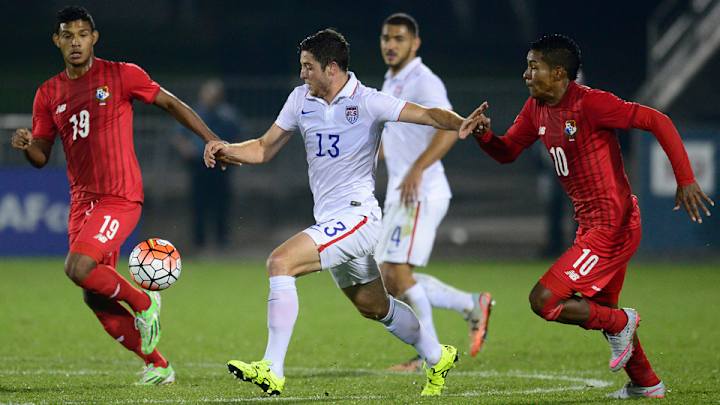Last chance for U.S. U–23s to reach playoff for an Olympic berth

SANDY, Utah – Being an Olympian in the United States holds special meaning and tradition in all sports. But in soccer, the general accepted belief is that the Olympics mean more to the U.S. than European nations. After all, their under-19 and under-21 continental tournaments as well as the club-based U-19 UEFA Youth League provide opportunities unmatched anywhere else in the world.
Nations in the Americas and Africa have embraced the Olympics as a chance to play against world-class opponents that they don’t get to see very often at any level. Being in the Olympics means something bigger to CAF and CONCACAF nations—and to a lesser extent, those in CONMEBOL—whose opportunities are more limited than their UEFA counterparts.
Nigeria’s Atlanta 1996 gold-medalist team included the likes of Celestine Babayaro and Jay-Jay Okocha, who went on to successful careers in Europe. Cameroon won the tournament four years later in 2000, when a U.S. team that included Landon Donovan and Tim Howard finished fourth.
Frustrated by Honduras, USA misses Olympic qualifying chance
“When the African teams did really well at the Olympics, the rest of the world saw that the African nations are getting better and better in soccer,” U.S. under-23 coach Andi Herzog said before qualifying started. “For the younger players, it’s the biggest tournament they can have. So I think it’s a dream of every one of us to be part of the Rio Olympic Games, and I think it’s one chance in a lifetime to participate in an Olympics.”
The Americans could fail to qualify for the second successive time, though, as they face a playoff against Colombia if they defeat Canada in their final CONCACAF qualifier on Tuesday. After winning its group with ease, scoring 13 goals and conceding just twice, the U.S. lost 2-0 to Honduras on Saturday in a semifinal that would’ve given the team automatic qualification.
The road to Rio will now take an unexpected detour through Rio itself, assuming the U.S. can beat a Canadian team that it defeated 3–1 in the first group match this month. The one-off match against Colombia will take place in Brazil during the FIFA window March 21–29 in 2016.
“There's a lot at stake,” U.S. senior coach and technical director Jurgen Klinsmann told ESPN this week. “If we don't qualify for the Olympics, we lose another generation of young players.”
U.S. U-23s fall to Honduras, fail to secure automatic Olympic berth
Let’s crunch some numbers.
Germany, winner of the 2009 U-21 Euro and 2014 U-19 Euro as well as the 2014 World Cup, marked its first qualification since 1988 by making Rio 2016. Belgium, which has crept into the conversation with the world’s best after a developmental overhaul, will also be there after finishing fourth in 2008—the nation’s first Olympics since the 1920s.
Argentina boasts probably the best Olympic record among top footballing nations in the world, having won gold in two of the last five and silver in 1996, and moved a remarkable number of those players onto the senior team. The 32 different players on its 2004 and 2008 gold-medal teams, not counting the three allotted over-age players, went onto a combined 1,032 senior caps before the current international break.
That’s an average of just more than 32 appearances per player. Javier Mascherano and Lionel Messi lead the way with 117 and 105, respectively.
Brazil is also high on the list after qualifying for four of the last five Olympics and failing to medal in just one of them despite never winning gold. The seleção seems to use the Olympics mostly as a laboratory for experimental squads that may or may not have an international future, as some never appear for the senior team. Its 30 players in its 2012 silver-medal and 2008 bronze efforts have combined for 485 senior caps, averaging just over 16 per player.
The U.S.’s numbers aren’t nearly as impressive.
Some of the best players in U.S. history appeared in the Olympics, including Donovan, Howard, Michael Bradley, DaMarcus Beasley and Brad Friedel. However, the 30 players under 23 who played in the 2000 and 2008 final tournaments have 185 caps among them, or just over six each.
Of the 20 who failed to qualify for London 2012, only Mix Diskerud made last summer’s World Cup squad, and nine have yet to earn their first cap. Meanwhile, Mexico’s gold-medal squad featured current senior-team regulars such as Héctor Herrera, Giovani dos Santos, Raúl Jiménez, Javier Aquino and Diego Reyes.
For the U.S., failing to qualify for two of the last three tournaments left the program in a developmental void, unsure if the upcoming crop of players had what it took to win on the world stage since they couldn’t even get past continental foes their own age. Rather than looking inward for the best prospects, U.S. coaches intensified their search for dual nationals playing in top leagues abroad.
Klinsmann continued that trend when he took over. Seven dual-nationals comprised part of his squad at the 2014 World Cup. At the same time, he has attempted to mend the shoddily paved road from the youngest national teams to his senior team. Strengthening that pipeline has been an often-touted part of his plan to overhaul the U.S. system.
“We want to see growth. We want to see those youngsters becoming confident and strong and giving us coaches alternatives to the already established players,” he told the federation’s website in January. “I think there’s talent coming through, whether it’s on U.S. soil or coming through other systems. That’s going to be an exciting topic. Over the first three years, we connected all the youth teams to the senior team. All the coaches work hand-in-hand and go in with all the age groups. I think that is all done. Now, we want to work on individual development of players on the field.”
As Klinsmann wanted, the connections among the three oldest teams in the pyramid have never been closer. Herzog, an assistant to Klinsmann with the senior team, coaches the U-23s. U-20 coach Tab Ramos is often on the bench next to Klinsmann as well.
U.S. soccer drops Bradley, Dempsey for friendly vs. Costa Rica
Six players from the 2015 U-20 World Cup team joined the U-23s this month, while four of the players have full international caps. The annual January training camp included 12 Olympic-age players in 2015 as Klinsmann emphasized identifying the right players to get the U.S. back into the Olympics.
“We talk about every talent coming through the ranks and we try to find even more talent,” Klinsmann said in April. “They need to understand that, in this very early stage of their career, that they are the drivers and that they are the decision-makers.”
Herzog previously coached the Austria U-21 team in its failed bid to qualify for the 2011 U-21 Euros and, ultimately, the 2012 Olympics. Eight players from his pool played for the Austrian team in qualifying that will compete at Euro 2016, including Bayern Munich star David Alaba.
“My goal and my wish for all the young players right now would be that we have a lot of young players breaking through the men’s national team,” Herzog said before the U.S.’s loss to Honduras. “As a soccer nation, you need young players breaking into an experienced group. First of all, you have to give them respect, of course, but after a while, you have to find your own way to compete with the starters in the men’s national team. That’s very important, to bring some fresh blood into every team.”
Ultimately, junior tournaments are as useful and significant as each nation decides to make them. Many European nations might not emphasize Olympic qualification except as a consequence of a U-21 Euro victory. On the other hand, Brazil uses it to weed out potential senior-team players.
Argentina wants to win every four years, funneling its players into a highly scrutinized senior program by pressuring them to win at every level. La Albiceleste stacks its Olympic teams with future stars such as Messi, Mascherano, Ángel di María and Sergio Agüero.
In loss to Mexico, U.S. beaten by the very skill it aspires to match
Since Klinsmann took over, he and his team have claimed that success at each level is vital. The U.S. could use the Olympics as a similar proving ground for players, along with the U-17 and U-20 World Cups, to take advantage of the few challenging youth competitions available for CONCACAF nations. In fact, the U.S. has qualified for the second-highest number of Olympic tournaments with 14; only Italy’s 15 ranks higher.
The U.S. U-23 team contains many of the program’s top prospects: Jordan Morris, Emerson Hyndman, Gedion Zelalem and Matt Miazga have drawn attention at various times, among others. With the team’s struggles in qualifying, though, it’s unclear just how much Klinsmann and his staff will be willing to trust those players on the senior level, just as they haven’t had much trust in the previous cycle’s players.
With the high priority Klinsmann and Herzog placed on qualifying for the Olympics, should the team fail to deliver for the third time in the last four cycles, it would be hard to categorize it as anything but a failure. Potentially, it could be the loss of another generation of American players on the international stage as well.
“Starting in MLS or in every league is very important too, but I think to get these international games on the highest level … is even more important,” Herzog said. “For a young player, it’s important to get an impression of how much work he has ahead of him [and] what he has to do for the future to be on the highest level, and that means on the World Cup level.”
